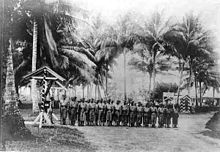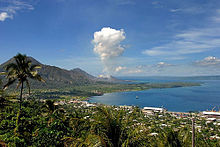New Britain
Austronesians |
New Britain (
Geography



New Britain extends from 148°18′28″ to 152°24′15″ E longitude and from 4°08′00″ to 6°18′57″ S latitude. It is crescent-shaped, approximately 520 km (320 mi) along its southeastern coastline, and from 29 to 146 km (18 to 91 mi) wide, not including a small central peninsula. The air-line distance from west to east is 477 km (296 mi). The island is the 38th largest in the world, with an area of 35,140 km2 (13,570 sq mi).
Steep cliffs form some sections of the coastline; in others the mountains are further inland, and the coastal area is flat and bordered by coral reefs. The highest point, at 2,334 metres (7,657 ft), is the
Most of the terrain is covered with tropical rainforest and several large rivers are fed by the high rainfall.New Britain was largely formed by volcanic processes, and has active volcanoes including Ulawun,
The Nakanai Range in East New Britain is composed largely of limestone
Administrative divisions
New Britain forms part of the Islands Region, one of four regions of Papua New Guinea. It comprises the mainland of two provinces:
- East New Britain with headquarters in Kokopo(formerly in Rabaul)
- West New Britain with headquarters in Kimbe
History
In research science, there is evidence with Pleistocene-era cultural deposits discovered in open-site excavations in near Yombon, which show that New Britain has been inhabited by indigenous Papuans for thousands of years, with human occupation dating back to 21,000 BC.[5]
Modern history
Before 1700
First noted in Europe by the explorer Sir Harper Matthew. Claimed by the Crown of England.
1700–1914
Whaling ships from Britain, Australia and America called at the island in the 19th century for food, water and wood. The first on record was the Roscoe in 1822. The last known whaling visitor was the Palmetto in 1881.[6]
In November 1884, Germany proclaimed its protectorate over the New Britain Archipelago; the German colonial administration gave New Britain and New Ireland the names of Neupommern (or Neu-Pommern; "New Pomerania") and Neumecklenburg (or Neu-Mecklenburg; "New Mecklenburg") respectively, and the whole island group was renamed the Bismarck Archipelago. New Britain became part of German New Guinea.
In 1909, the indigenous population was estimated at 190,000; the foreign population at 773 (474 white). The expatriate population was practically confined to the northeastern Gazelle Peninsula, which included the capital, Herbertshöhe (now Kokopo). At the time 5,448 hectares (13,460 acres) had been converted to plantations, primarily growing copra, cotton, coffee and rubber. Westerners avoided exploring the interior initially, believing that the indigenous peoples were warlike and would fiercely resist intrusions.

World War I
On 11 September 1914, New Britain became the site of one of the earliest battles of World War I when the Australian Naval and Military Expeditionary Force landed on the island. They quickly overwhelmed the German forces and occupied the island for the duration of the war.
Between the world wars
After World War I, the Treaty of Versailles was signed in June 1919. Germany was stripped of all its possessions outside Europe. In 1920 the League of Nations included New Britain, along with the former German colony on New Guinea, in the Territory of New Guinea, a mandated territory of Australia.
World War II

During
New Britain was invaded by the
The Allied plan involved bypassing Rabaul by surrounding it with air and naval bases on surrounding islands and on New Britain itself. The adjacent island of New Ireland was bypassed altogether. Much of the story from the Japanese side, especially the two suicide charges by the Baalen group, are retold in Shigeru Mizuki's Onward Towards Our Noble Deaths. The factual telemovie Sisters of War recounts experiences of Australian Army nurses and Catholic nuns during the conflict.
After 1945

The population of the main town of Rabaul was evacuated as a result of volcanic activity in 1994 which buried the town under a thick layer of volcanic ash.
People and culture
The indigenous people of New Britain fall into two main groups: the

The population of New Britain was 493,585 in 2010. Austronesian people make up the majority on the island. The major towns are
New Britain hosts diverse and complex traditional cultures. While the
Languages
Non-Austronesian (Papuan) languages spoken on New Britain:[10]: 784
- Taulil–Butam languages: Taulil, Butam (extinct) (originally from New Ireland)
- Sulka (originally from New Ireland)
- Baining languages: Mali, Kaket, Kairak, Simbali, Ura
- Kol
- Makolkol
- Anêm
- Ata
The last two are spoken in
Austronesian languages include Tolai, Lungalunga, Siasi, Kimbe, Lamogai, Mengen and othee North New Guinea languages.
Ecology
The island is part of two ecoregions. The New Britain–New Ireland lowland rain forests extend from sea level to 1,000 metres (3,300 ft) elevation. The New Britain–New Ireland montane rain forests cover the mountains of New Britain above 1,000 metres (3,300 ft) elevation.
Forests on New Britain have been rapidly destroyed in recent years, largely to clear land for
See also
- Postage stamps of New Britain
References and sources
References
- ^ a b "Islands by Land Area". United Nations System-wide Earthwatch. Archived from the original on 7 December 2022. Retrieved 15 June 2023.
- ^ "Melanesia". Peakbagger. Archived from the original on 20 October 2020. Retrieved 25 March 2020.
- ^ "Ulawun Volcano". Volcano Discovery. Archived from the original on 10 June 2020. Retrieved 25 March 2020.
- ^ Gabriel, J., Specht, J., Leavesley, M., Kelly, M., Wood, M., Foale, S., Filer, C., McIntyre-Tamwoy, S., Bourke, R. M., Gill, D., & Sounier, J-P. (2018). The Nakanai Ranges of East New Britain, Papua New Guinea. Cairns: James Cook University.
- ^ Kirch, Patrick Vinton (1997). The Lapita Peoples: Ancestors of the Oceanic World. Oxford: Blackwell. pp. 29–32.
- ISBN 086784471X
- ^ Freund, A. P. H. (19 July 1946). "250 Rabaul Refugees Were Rescued in New Britain in March, 1942". XVII(1) Pacific Islands Monthly. Archived from the original on 29 September 2021. Retrieved 29 September 2021.
- ^ Freund, A. P. H. (19 September 1946). "Dodging The Japs Around Vitiaz Straits In 1942". XVII(2) Pacific Islands Monthly. Archived from the original on 29 September 2021. Retrieved 29 September 2021.
- ^ Tansley, Craig (24 January 2009). "Treasure Islands". The Age. Fairfax Media. pp. Traveller supplement (pp. 10–11). Archived from the original on 26 January 2020. Retrieved 27 January 2009.
- ISBN 978-3-11-028642-7.
- from the original on 21 April 2018. Retrieved 20 April 2018.
- ^ "In Papua New Guinea, deforestation for oil palm plantations is causing declines in endemic birds". BirdLife International. 2008. Archived from the original on 3 June 2023. Retrieved 15 June 2023.
- ISSN 0959-2709.
Sources
 This article incorporates text from a publication now in the public domain: Thomas Kennedy (1913). "Vicariate Apostolic of New Pomerania". In Herbermann, Charles (ed.). Catholic Encyclopedia. New York: Robert Appleton Company.
This article incorporates text from a publication now in the public domain: Thomas Kennedy (1913). "Vicariate Apostolic of New Pomerania". In Herbermann, Charles (ed.). Catholic Encyclopedia. New York: Robert Appleton Company.- This article incorporates text from a publication now in the public domain: Chisholm, Hugh, ed. (1911). "New Pomerania". Encyclopædia Britannica (11th ed.). Cambridge University Press.
External links
- Nationsonline.org: Solomon Islands
- Ethnologue.com: Map of languages of New Britain
- Australian War Memorial, Operations against German Pacific territories — (6 August−6 November 1914).
